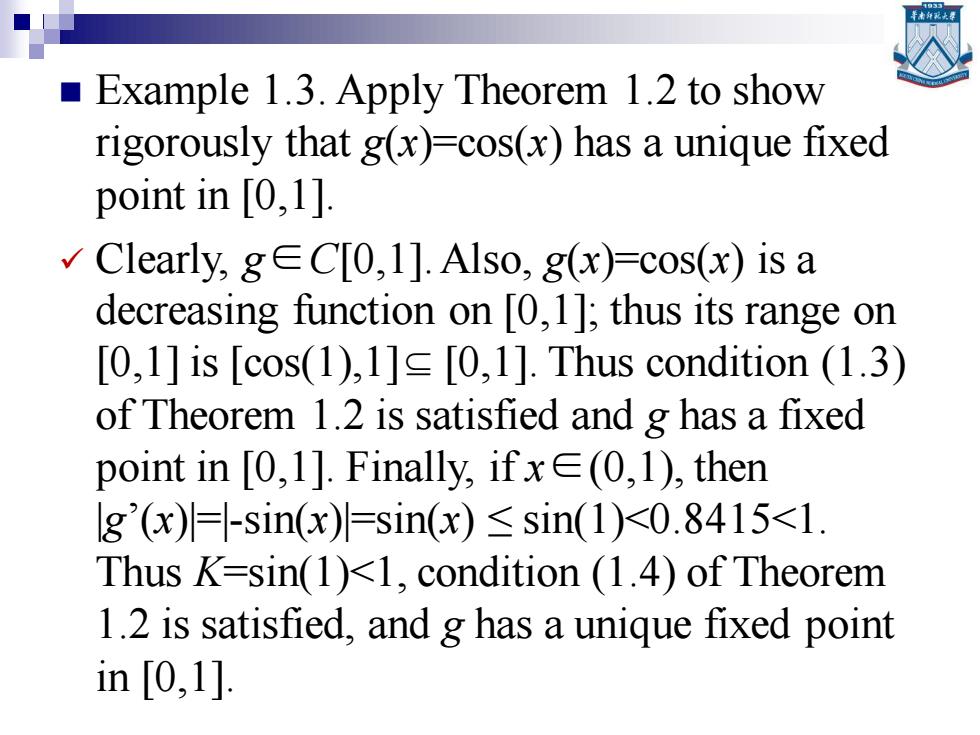
■ Example 1.3.Apply Theorem 1.2 to show rigorously that g(x)=cos(x)has a unique fixed point in [0,1]. Clearly,gEC[0,1].Also,g(x)=cos(x)is a decreasing function on [0,1];thus its range on [0,1]is [cos(1),1]s [0,1].Thus condition (1.3) of Theorem 1.2 is satisfied and g has a fixed point in[0,l].Finally,.ifx∈(0,I),then g(x)=-sin(x)=sin(x)≤sin(1)<0.8415<1. Thus K=sin(1)<1,condition(1.4)of Theorem 1.2 is satisfied,and g has a unique fixed point in[0,1]
◼ Example 1.3. Apply Theorem 1.2 to show rigorously that g(x)=cos(x) has a unique fixed point in [0,1]. ✓ Clearly, g∈C[0,1]. Also, g(x)=cos(x) is a decreasing function on [0,1]; thus its range on [0,1] is [cos(1),1] [0,1]. Thus condition (1.3) of Theorem 1.2 is satisfied and g has a fixed point in [0,1]. Finally, if x∈(0,1), then |g’(x)|=|-sin(x)|=sin(x) ≤ sin(1)<0.8415<1. Thus K=sin(1)<1, condition (1.4) of Theorem 1.2 is satisfied, and g has a unique fixed point in [0,1].
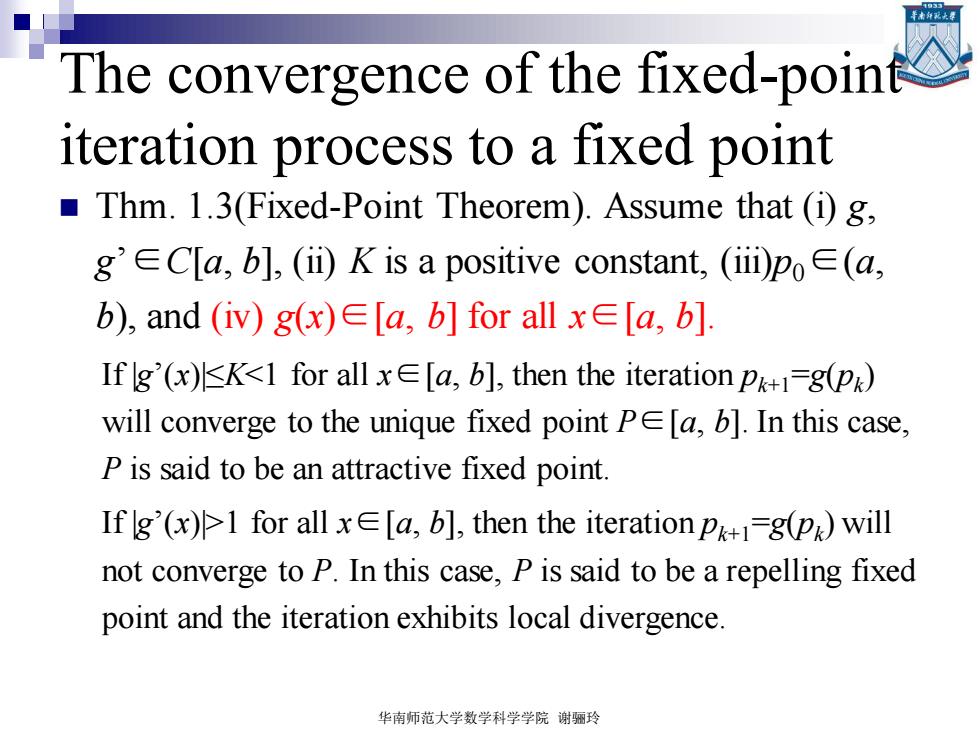
The convergence of the fixed-point iteration process to a fixed point Thm.1.3(Fixed-Point Theorem).Assume that (i)g, g'ECla,b],(ii)K is a positive constant,(iii)poE(a, b),and(iv)g(x)∈[a,b]for all x∈[a,b]. If lg'(x)K<1 for all x[a,b],then the iteration p-g(p) will converge to the unique fixed point Pe[a,b].In this case, P is said to be an attractive fixed point. If lg(x1 for allx[a,b],then the iterationp=g(p)will not converge to P.In this case,P is said to be a repelling fixed point and the iteration exhibits local divergence. 华南师范大学数学科学学院谢骊玲
The convergence of the fixed-point iteration process to a fixed point ◼ Thm. 1.3(Fixed-Point Theorem). Assume that (i) g, g’∈C[a, b], (ii) K is a positive constant, (iii)p0∈(a, b), and (iv) g(x)∈[a, b] for all x∈[a, b]. If |g’(x)|≤K<1 for all x∈[a, b], then the iteration pk+1 =g(pk ) will converge to the unique fixed point P∈[a, b]. In this case, P is said to be an attractive fixed point. If |g’(x)|>1 for all x∈[a, b], then the iteration pk+1 =g(pk ) will not converge to P. In this case, P is said to be a repelling fixed point and the iteration exhibits local divergence. 华南师范大学数学科学学院 谢骊玲
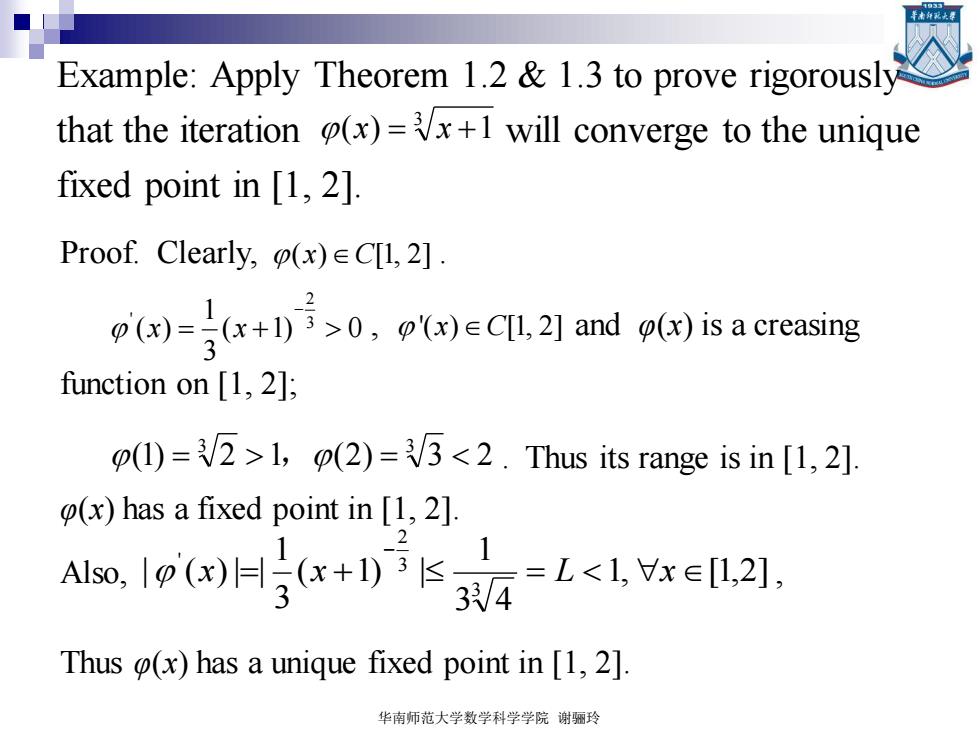
Example:Apply Theorem 1.2 1.3 to prove rigorously that the iteration (x)=x+1 will converge to the unique fixed point in [1,2]. Proof.Clearly,(x)E C[1,2]. p()-x+D号>0,p∈CTL,2]and isaereasing function on [1,2]; (1)=,(2)=3<2.Thus its range is in [1,2]. (x)has a fixed point in [1,2] Also.l@(w)Hz(x+D)-L<I.Vxe[2]. 34 Thus (x)has a unique fixed point in [1,2]. 华南师范大学数学科学学院谢骊玲
华南师范大学数学科学学院 谢骊玲 Example: Apply Theorem 1.2 & 1.3 to prove rigorously that the iteration will converge to the unique fixed point in [1, 2]. 3 (x) = x +1 Proof. Clearly, . , and φ(x) is a creasing function on [1, 2]; . Thus its range is in [1, 2]. φ(x) has a fixed point in [1, 2]. Also, , Thus φ(x) has a unique fixed point in [1, 2]. ( ) [1, 2] x C ( 1) 0 3 1 ( ) 3 2 ' = + − x x (1) 2 1 (2) 3 2 3 3 = , = 1, [1,2] 3 4 1 ( 1) | 3 1 | ( )| | 3 3 2 ' = + = − x x L x '( ) [1, 2] x C
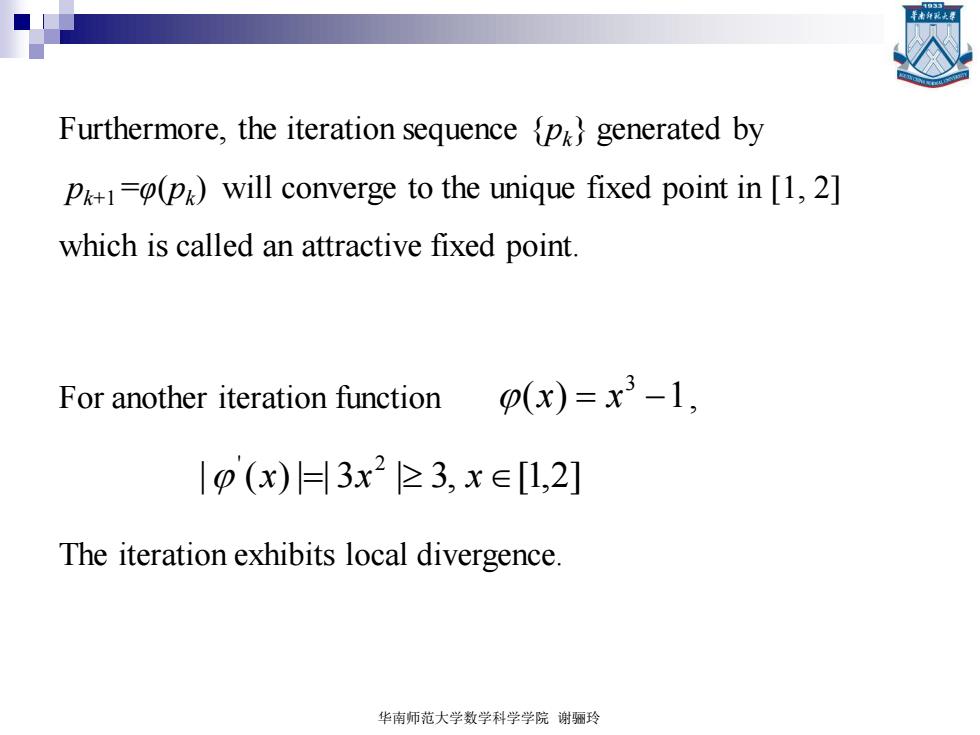
Furthermore,the iteration sequence {p}generated by P(p)will converge to the unique fixed point in [1,2] which is called an attractive fixed point. For another iteration function p(x)=x3-1, |p(x)曰3x223,x∈[1,2] The iteration exhibits local divergence. 华南师范大学数学科学学院谢骊玲
Furthermore, the iteration sequence {pk} generated by pk+1 =φ(pk ) will converge to the unique fixed point in [1, 2] which is called an attractive fixed point. For another iteration function , . The iteration exhibits local divergence. ( ) 1 3 x = x − | ( ) | | 3 | 3, [1,2] ' 2 x = x x 华南师范大学数学科学学院 谢骊玲
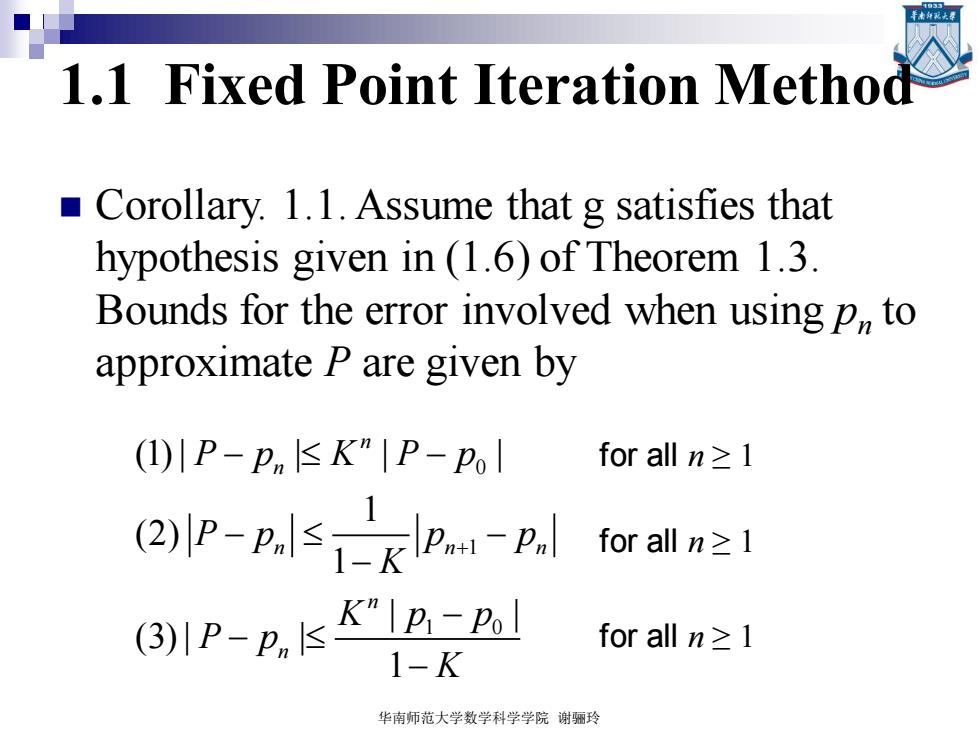
1.1 Fixed Point Iteration Method Corollary.1.1.Assume that g satisfies that hypothesis given in (1.6)of Theorem 1.3. Bounds for the error involved when using p,to approximate P are given by (I)川P-pnKK"|P-p| for all n≥1 (2P-ps已kP-p for all n≥1 (3)IP-P IK K"IPI-Pol for all n≥1 1-K 华南师范大学数学科学学院谢骊玲
1.1 Fixed Point Iteration Method ◼ Corollary. 1.1. Assume that g satisfies that hypothesis given in (1.6) of Theorem 1.3. Bounds for the error involved when using pn to approximate P are given by 0 1 1 0 (1) | | | | 1 (2) 1 | | (3) | | 1 n n n n n n n P p K P p P p p p K K p p P p K + − − − − − − − − for all n ≥ 1 for all n ≥ 1 for all n ≥ 1 华南师范大学数学科学学院 谢骊玲